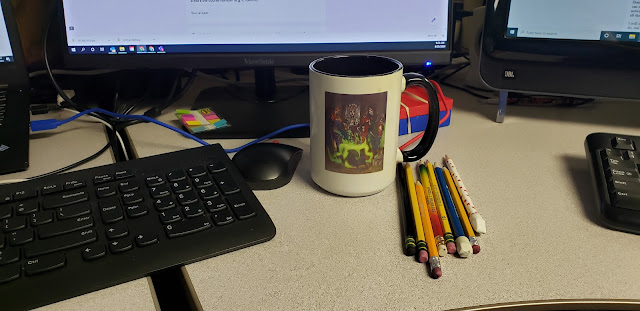Today I am talking with Christopher Grey, designer of The Great American Novel and The Great American Witch (Games) and author of Goddamn F*cking Dragons, Will Shakespeare and the Ships of Solomon. (Novels)
Christopher is currently coming to the end of his latest Kickstarter for The Great American Witch.
https://www.kickstarter.com/projects/greyauthor/the-great-american-witch?ref=theotherside
Tim Brannan/The Other Side: Let’s start at the beginning, who are you and what do you do?
Christopher Grey: I’m Christopher Grey and I’m a game designer and novelist. I created The Happiest Apocalypse on Earth, an ENnie-nominated PBTA game about an evil children’s theme park, and The Great American Novel RPG, which was recently nominated for the Indie Groundbreaker Award.
TB: How did you get into gaming?
CG: It’s hard to pinpoint a starting place, I feel like I’ve always been gaming. When I was eight I was making board games on my dad’s file folders. My first RPG design happened somewhere in the neighborhood of 15 or 16. In the early days I played AD&D 2e, then graduated to Rifts, then hobbled over to World of Darkness. I think it’s fair to say I’ve been playing some sort of RPG for at least thirty years.
TB: What are some of your favorite games? Why?
CG: It’s so hard to choose! And it changes fairly regularly. I basically love anything Free League puts out and their latest game Vaesen I think is a masterpiece. The game system is slick and easy and the setting/content is perfection. But they get lots of love, so I’d like to point out some of my favorite indy games. I’m a big fan of Monkeyfun Studios and they are close friends--Bedlam Hall is still on my list of all-time favorite games. I mean you basically get to play Downton Abbey meets The Addams Family. I think Kimi Hughes’ Decuma is a huge innovation in gaming and I shamelessly robbed her approach for a game concept of my own. I’m a big fan of world-building games like Dialect and Microscope. Ten Candles is also top of my list. Oh! And Icarus… that kind of lands in the world-building category. For the Queen changed my understanding of game design. Really loving Lighthearted by Kurt and Kate Potts. I should probably stop. I love so many games.
TB: Very cool! Let’s get into what is important! What is The Great American Witch?
CG: The Great American Witch is an RPG where you get to play in the secret world of witches as they protect humanity from supernatural threats and secret societies. It was built on The Great American Novel chassis so it is story and character-focused. It is designed for campaign play of the kind you see from World of Darkness games.
TB: What sorts of games do you see others playing with these rules?
CG: The rules are highly tuned into the Great American Witch setting and experience. I think folks will have a tough time playing something other than powerful secret witches with the ruleset. However, it was adapted from a generic rule system that has a lot of flexibility. I do intend to expand this rule set into other categories of the GAW fictional universe. So stay tuned on that!
TB: How does it relate to your earlier game, the Great American Novel, and can the two be used together?
CG: Great American Witch adapted the GAN rule-set heavily in order to create an experience unique to it. They aren’t really compatible as they are working toward different things. GAN is designed for one-shots or short campaigns of a literary nature (the sorts of slow-moving narratives you find in classic literature), whereas GAW is designed for extended play that creates cinematic experiences (like the dramatic tension you find from your favorite streaming shows). However, if you’ve played GAN you’ll find a familiar approach to game design--one that focuses on characters and motivations, not on attack rolls or skills.
TB: Of course while the title is clearly an homage to your earlier game, I have to ask are you a Rob Zombie fan? And was the title inspired by his “American Witch”?
CG: I almost didn’t go that direction in order to differentiate it from American Witch. I do like Rob Zombie, but this experience is more like American Horror Story: Coven, the Craft, or True Blood. Ultimately I couldn’t resist calling back GAN since that is the primary engine running it. Plus, it has a nice ring to it.

TB: I loved American Horror Story: Coven and The Craft! What are your future plans for this game?
CG: Oh so much. I intend to work in this system and setting for quite some time. I’ve already started supplements for GAW that will include more play options (such as covens and crafts) as well as additional settings within the same world. I’m also working on other types of games for the setting, such as a story-prompt card game that is already in the editing phase. Eventually, I will expand to other supernatural groups, like the Illuminati, vampires, werewolves, etc. Frankly, I’ll be doing this for a while.
TB: Nice. That sounds great. And for me and my audience here. Who is your favorite wizard, witch, or magic-user?
CG: Considering the amazing examples of magic-users throughout recorded history, this is a hard one. Ultimately, I’d have to say Kiki from Kiki’s Delivery Service. I just absolutely love that movie and character.
TB: I adore Kiki! She is fantastic. Finally, where can we find you on the internet?
CG: Best place is my site christopher.world where I keep all my stuff and links to my social channels.
Links:
https://www.christopher.world/
https://twitter.com/greyauthor
https://www.drivethrurpg.com/browse/pub/12812/Christopher-Grey





















